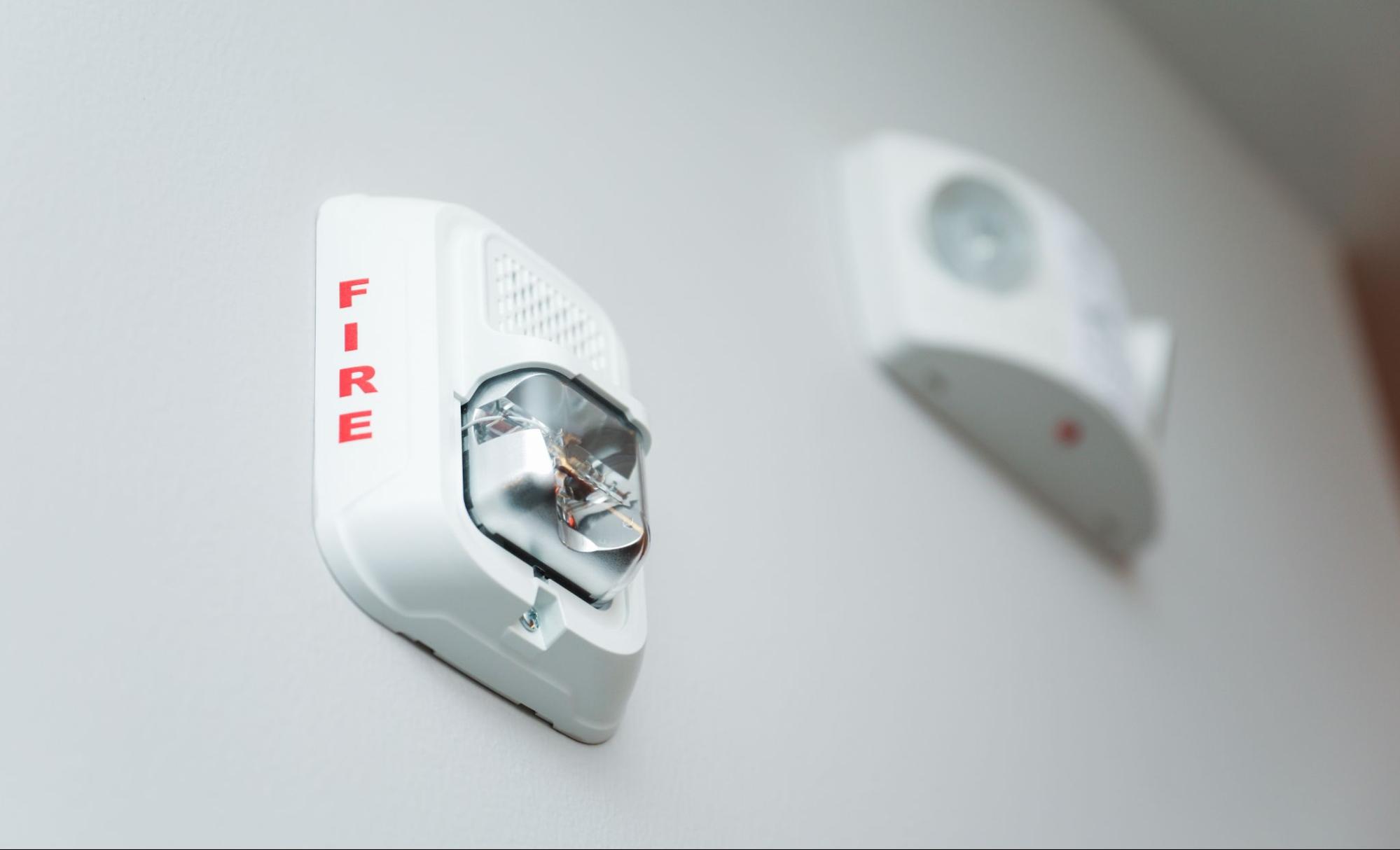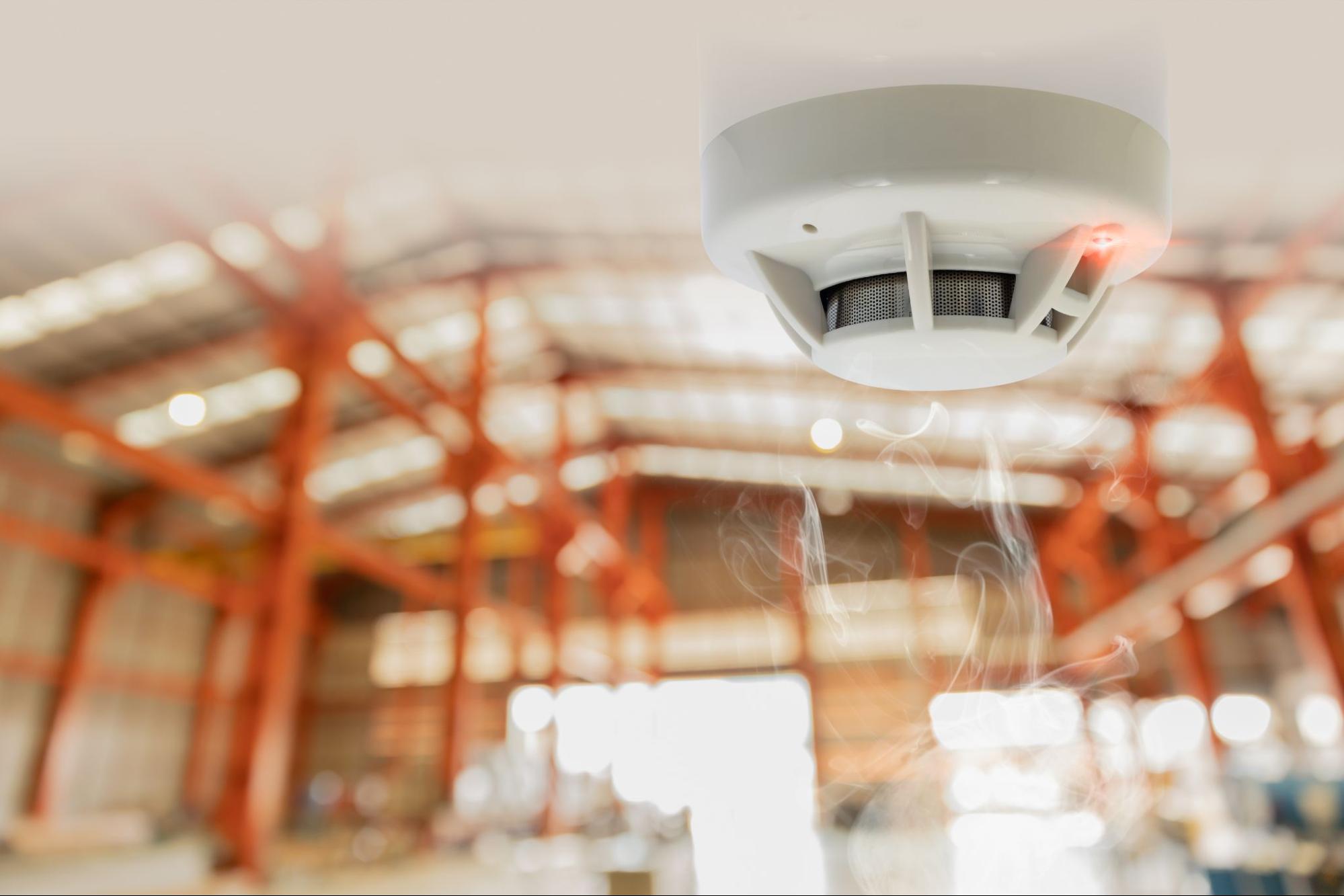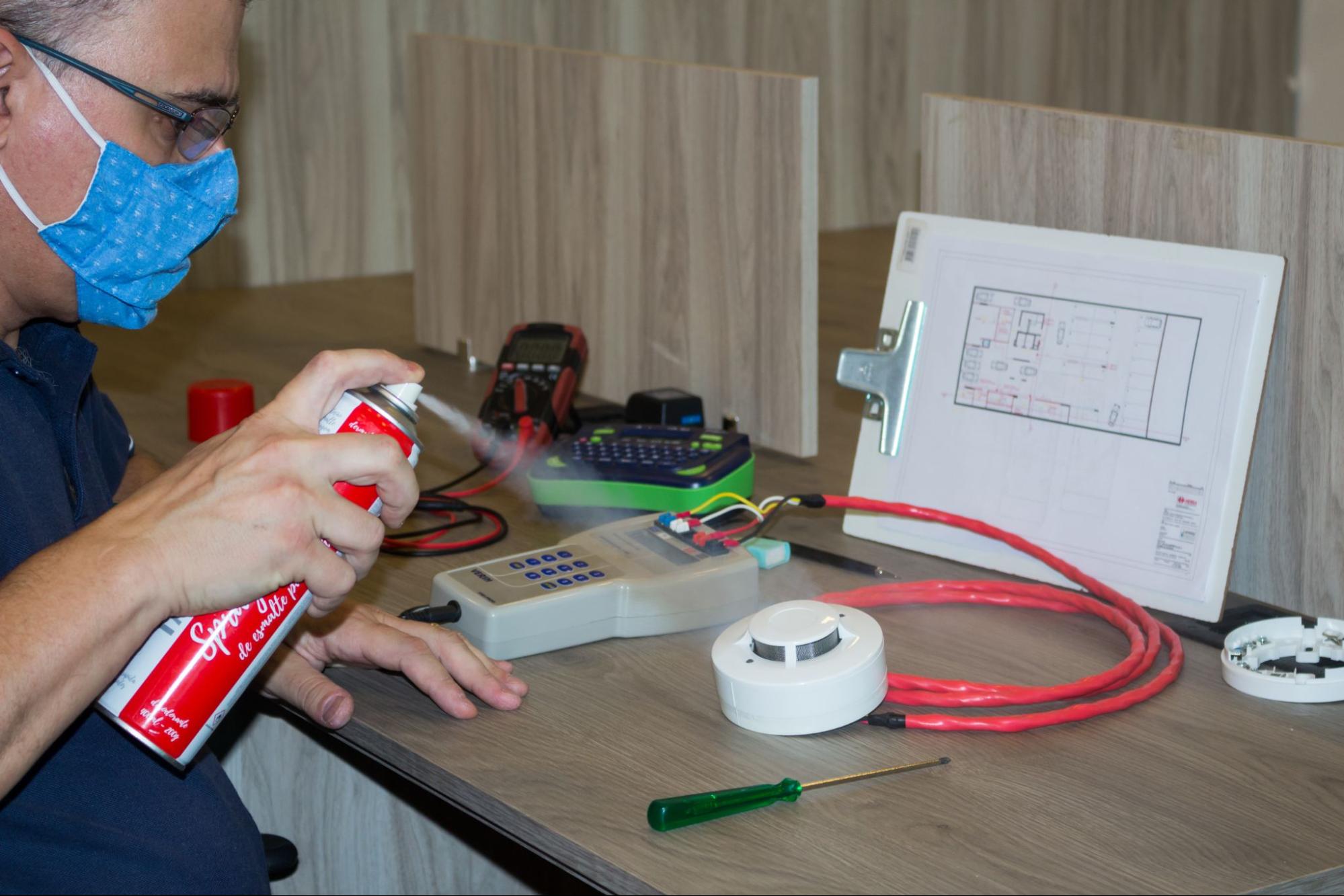1300 001 004

Fire detection and alarm systems are an important safety feature of any building, so it’s critical that they are installed and functioning to Australian standards. AS1670 outlines all requirements for the design, installation, commissioning and integration of fire detection, fire alarm and occupant warning systems. Adhering to this standard for your building can give you the peace of mind that your fire safety system will function as intended when needed most in a real-life emergency situation.
At Alexon, our expert team provides commercial clients and building managers with complete compliance to AS1670 with professional fire equipment maintenance, inspections and testing. Regular servicing and testing by our qualified fire experts keeps all detectors, alarms, visual devices, and control panels fully operational, adequately documented and ready to perform when an emergency arises.
Our fire safety experts have compiled this easy-to-understand breakdown of AS1670 to provide you with everything you need to know to keep your building compliant, safe and prepared for any emergency.
AS1670 is the Australian Fire Safety Standard detailing the design, installation and commissioning requirements for fire detection, alarm and warning systems installed in buildings. The Standard sets the technical parameters and requirements to ensure the systems are capable of early fire detection, notifying building occupants, and reliable and continued operation during all circumstances including power failure or system faults.
The Standard applies to all classes of buildings and all types of fire detection and alarm systems including simple smoke alarm installations and fully networked addressable fire indicator panels (FIPs). The Standard sets minimum performance requirements for detection coverage, alarm audibility, and the interconnection between other fire protection systems such as sprinklers, smoke control systems, and emergency warning systems.
AS1670 has an important role in all facets of the fire protection industry and for all stakeholders in the design, installation, inspection, maintenance and testing of these systems. From fire engineers and system designers who need to demonstrate compliance as part of the approval process, to installers and contractors who need to ensure all system wiring, zoning and control equipment is in accordance with AS1670. For building owners and facility managers, AS1670 is the basis for meeting the National Construction Code’s (NCC) fire safety obligations and certification.
AS1670 does not stand alone; there are several other Australian Standards that are applicable in different areas to provide a comprehensive approach to building protection during the entire life cycle of a fire safety system. AS1670 outlines requirements and guidelines for the installation of fire alarms and the system design and design of the fire detection system. It does not, however, extend beyond when the installation of the system is complete.
Standards such as AS1851 provide guidelines on inspection, testing and fire alarm maintenance, with requirements for ongoing inspection and testing of all detectors, sounders and control equipment, to ensure the ongoing and reliable operation of the system. AS1668 contains requirements and guidelines for smoke control and ventilation, and the NCC includes mandatory performance requirements for construction.
They all work together to create a comprehensive compliance journey. In the case of fire detection and alarms, a system must be designed and installed according to AS1670, then maintained and regularly tested according to AS1851, and of course, the building as a whole must comply with the NCC.
The AS1670 standard is split into a range of different parts, each one of which is specific to various building types and fire safety system requirements. This division of the standard into many different components allows for each type of fire detection, alarm, and occupant warning system to be designed, installed, and commissioned in a manner that is fit for its purpose and application.
Knowing which part of AS1670 is relevant to your premises can make the standard much easier to understand and follow.
This is the most referred part of the standard and relates to most commercial, residential and industrial premises. It details the design and performance requirements of fire detection systems including smoke and heat detectors, control panels, alarm sounders and defines the zoning and layout of detectors and alarm circuits that should be installed to ensure correct detection, clear warning of occupants and effective system monitoring.
If you are a building owner and are looking at upgrading an existing building this part of the AS1670 series is vital in ensuring the installation of a new system or retrofitting an old one works with the existing infrastructure and minimising problems like false alarms and constant smoke alarm beeping.
Meeting requirements outlined in AS1670.1 will also ensure your smoke alarm installation and fire detection system as a whole is compliant with Australia's National Construction Safety Standards, and give you and your occupants peace of mind through consistent reliability.
Tailored for high-security settings, this section addresses tamper-resistant installation practices, system integrity, and secure access to control panels and manual call points. It also provides for safe interfacing of fire detection systems with custodial security features, such as automatic door release, surveillance and intercom, to allow safe evacuation without jeopardising security.
This section covers the requirements for the design and installation of emergency warning systems and public address and intercommunications systems, as part of a broader fire safety plan for buildings. This includes sound levels, placement of speakers, speech intelligibility and emergency communications to provide clearly audible notification and warning messages to occupants so they may hear and understand directions or announcements for emergency evacuation or other protective action.
Interface requirements with other types of fire protection equipment are also included such as smoke detectors, alarm panels, annunciators, mass notification, and sprinkler systems.

AS1670.1 sets out detailed technical parameters to ensure that every fire detection and alarm system performs reliably under real-world conditions — including during power failures, environmental fluctuations, or equipment faults.
While the standard’s scope is extensive, several core design and installation principles form the foundation of compliant, high-performing systems:
Detector coverage is important to get good, reliable and early fire detection. Under AS1670, coverage is dependent on a number of factors including ceiling height, air flow patterns and the environmental conditions of the protected zones. Detectors need to be placed in locations that will detect smoke or heat as early as possible without being affected by ducted air-conditioning vents or physical obstructions that could impede detector performance.
Coverage is also affected by the traffic flow of occupants and other equipment or machinery that may impede airflow in areas where fire alarms are fitted in the workplace. The location of each detector will be dependent on the above variables and will be calculated to ensure detectors are at the correct sensitivity for the alarm system to respond effectively and provide those vital few seconds to evacuate the premises and activate the system.
Under the Australian Standard AS1670, zoning of fire compartments has to be performed so the source of the alarm can be easily identified. Zoning and mapping will allow first responders and the building wardens to accurately identify the location of the problem which should result in a shorter response time and limited loss of damage or disruption.
The zones have to be indicated and labeled consistently on all fire indicator panels and the visual indication and zone descriptions have to match the building's fire safety documentation. This enables a rapid evacuation but also allows maintenance teams to isolate and test the area affected.
AS1670 mandates that fire detection and alarm systems be designed such that they maintain 100% capability during power supply failures. To this end, every system must be provided with an independent secondary power supply (usually a dedicated battery supply) sufficient to power the full system for the required duration as stated in the standard. Verification and discharge tests performed on a regular basis ensure that batteries have the required capacity and that the charging system is functioning correctly.
AS1670 mandates all detection and alarm circuits be continuously supervised for open, short or earth faults at the first instance of their occurrence. This degree of supervision enables any wiring defect or disconnection of a device to be directly communicated to the control equipment for continuous integrity monitoring. Correct fault annunciation assists in the quick identification of a problem area for timely corrective action.
AS1670 makes a requirement that all fire detection and alarm system wiring should be fire rated and installed as part of an approved cabling method. Segregation of the required circuits is also necessary from other electrical services to avoid electromagnetic interference and for circuit integrity in the event of a fire.
Correct choice of cable, routing and support should also be considered in order to maintain signal integrity and the long-term operation of the system. Terminations, junctions and containment should be inspected to ensure continued compliance with standards and full operational capability.
Accurate and complete documentation is a fundamental principle of AS1670. Each fire detection and alarm system should be supported by a set of record drawings, equipment schedules, and commissioning certificates, that reflect as-built conditions. These records provide a basis for verification, testing and ongoing maintenance.
Updated documentation should also be available when an annual fire safety statement is prepared, to confirm that the system continues to operate to design intent, and meets current compliance requirements. Clear and traceable records also help to maintain accountability, support future modification work, and make the audit and certification process more efficient.
Before an AS1670 system can be certified, it must undergo a comprehensive commissioning process. This includes:
Functional testing is the process of verifying that a fire detection and alarm system performs the correct functions, in the correct sequence, and to the required standard. For each detector, sounder and indicator, AS1670 requires activation and testing to verify correct operation, response times and coordination with other devices and system components. This includes ensuring devices respond correctly to fire conditions, that alarms and signals are raised as required, and that inter-panel and inter-detection loop connections are working correctly.
Comprehensive fire alarm testing during commissioning and periodic maintenance is important for verifying correct operation of all devices, and for identifying any system faults or misconfigurations.
Interface testing verifies that the fire detection and alarm system interfaces successfully with other systems within the building. AS1670 requires detectors and alarm devices when activated to successfully activate connected systems, such as sprinklers, HVAC shutdown, smoke control systems, and emergency exit lighting. This coordinated response is vital to ensure that fire and smoke can be controlled, safe evacuation paths are maintained, and life safety is provided to the entire building.
Interface testing, both as part of commissioning and ongoing maintenance, can help find interface communication issues or delays so technicians can correct problems before they affect system operation. Interface verification can ensure all systems are properly coordinated and are working together to provide a reliable, fully integrated fire safety solution.
Acceptance of a fire detection and alarm system does not occur until all relevant documentation, installation and function test reports have been examined and signed off by a competent certifier or fire engineer. The acceptance certificate provides a record that the fire detection and alarm system has been installed and commissioned according to the AS1670 and will function dependably in practice. Acceptance also gives the owner confidence that all the detectors, sounders, control panels and any other interface systems will perform as specified.
During the system audits, some common issues can stop a fire detection or alarm system from being compliant with AS1670. These can range from minor oversights during installation to documentation errors that have major compliance impacts discovered later.
Some examples are detectors installed too close or too far apart, missing or outdated system drawings or diagrams, or cabling that has not been labelled or installed to the required standard. Interface faults between the fire system and the building management system are also common if these connections are not programmed and tested properly.
Fixing these errors early on can help to avoid rework costs, certification delays, and potential compliance penalties. By having a regular inspection and testing regimen performed by qualified fire safety technicians, any non-conformances are less likely to become significant issues.
Be sure to check for these non-conformances when assessing AS1670 compliance:

When your fire alarm installation has been completed it is important to remember that maintenance of the system is just as important as the design and installation of the system itself. AS1670 systems must be maintained in accordance with AS1851. This Standard prescribes the inspection, testing and reporting requirements to maintain your fire detection and alarm systems in a fully operational and compliant condition.
This should include regular testing of detectors, sounders and alarm controls to ensure all devices are working and event logs are correctly logging. Any modifications to the system including new zones, new panels or new devices must be recorded to ensure full traceability.
Building owners and building managers should also ensure that maintenance logbooks and test reports are kept up to date. This will provide you with the necessary evidence of compliance at the time of an audit or fire safety inspection. Regular maintenance and system reviews will also help to ensure that your systems are still in compliance with the latest version of AS1670 and are protecting both your building occupants and your ongoing compliance obligations.
To stay compliant, work with qualified fire safety technicians like the team at Alexon. Our specialists provide routine servicing, documentation support, and expert advice to ensure your fire alarm installation remains fully compliant with AS1670 and AS1851 standards.
Complying with AS1670 is about more than just ticking a box; it’s about safeguarding people, property, and peace of mind. By ensuring your system is designed and installed to this standard, you can be confident that your fire detection and alarm system will work when you need it most.
A fire can start at any time, and in an emergency, every second counts. AS1670 covers everything from early detection of smoke or heat to the activation of alarms and safe evacuation. It also ensures that your fire suppression systems will remain operational during a power outage or other emergency situation. Compliance with AS1670 also helps you minimise your legal and insurance exposure by providing evidence that you have fulfilled your obligations under workplace health and safety and building regulations.
On the other hand, non-compliance can result in serious consequences, from hefty fines and insurance claims to the much greater risk of injury or damage to building occupants and property.
At Alexon, we specialise in the design, installation, and certification of AS1670-compliant fire detection and alarm systems. Our qualified technicians and engineers ensure every project meets or exceeds the requirements of AS1670, AS1668, and AS1851.
We also provide comprehensive fire system audits, documentation support, and system upgrades to help your building remain compliant as standards evolve.
If you’re looking to ensure your fire detection systems meet AS1670 requirements, contact Alexon today on 1300 001 004 or submit an enquiry online to book your next fire safety inspection.
Complete the form to request a call
from a friendly Alexon team member.